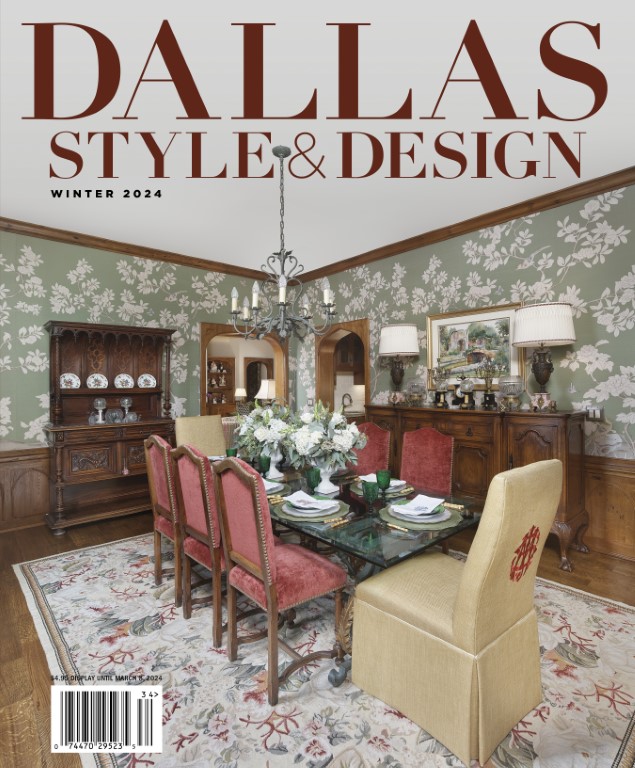
Imagine you are relaxing in your living room, surrounded by elegant furnishings and accessories, when you see the family dog sniffing at the new Indo-modern rug beneath the coffee table. You watch with curiosity as the dog turns in a tight circle once, twice, three times. Suddenly, you bolt from your seat in a panic as your sweet family pup starts to piddle on the hand-knotted fibers.
“I’ve had several customers tell me that if they had to choose between their dog and their rug, it’s going to be their dog every single time,” says Bryce Smith, manager of RenCollection. The Dallas Design District showroom specializes in exquisite rugs from around the globe, including Iran, Turkey, India and Central Asia, as well as rug appraisal, cleaning and repair services. The good news, notes Smith, is that you don’t have to choose between your dog and elegant design. Fido and fine furnishings can peacefully coexist. “It just takes a little investment,” he says.
A self-professed dog lover, Smith has fostered 200 rescue canines over the past three years. “Not a single one of them has chewed my rugs,” he notes. He currently has six dogs at home and likewise swiftly trains new additions to do their business outdoors. Teaching a dog proper boundaries and behaviors in advance can help homeowners protect expensive furnishings, whether a high-end sofa or Oriental rug, and reduce the risk of damage, Smith says.

“Training starts from the moment you bring a new dog into the home,” notes dog trainer Madeline Wren, owner of Legendary Canines, LLC in Rockwall, Texas. This includes establishing a regular routine and assigning words to commands, like saying “outside” while leading the pup to the yard to go potty. Later, just saying the command will direct the dog to the proper location.
In the same way, pet owners can teach their dog that an elegant area rug is off-limits. She recommends leading the dog on a leash to the rug, and as soon as its paws touch the pile, say the word “off” while using body posture to pressure the dog away from the textile. When the dog obeys, it should be rewarded with a treat or affection. After a few days of practice, both on and off the leash, the pup will understand that the rug is a no-go zone and behave accordingly. “In the beginning, do not leave room for error,” notes Wren. “Always supervise the new area and be consistent with the command and reward.”
If something does happen to the rug because the dog was sick, poorly trained or anxious, RenCollection offers cleaning and restoration services to make it good as new.
“A bamboo silk rug is not ruined if you have a spot on it,” says Smith. “You just have to clean the entire rug.” Similarly, stains are easily removed from natural silk and wool rugs by having the whole rug cleaned, rather than treating one spot. Although dog urine can potentially discolor rugs made with vegetable dye, even then, RenCollection can restore fibers to the proper shade. The 8,000-square-foot showroom also offers rug repair and restoration services if a dog chews off a corner or moths eat through the fibers. “Whether it’s antique, Persian, Turkish, or even Indo-modern or Moroccan-style rugs, we fix anything, and anything can be cleaned,” Smith says.

The personable showroom manager recommends having fiber seal applied to a rug, before delivery, to make it liquid resistant. “Nothing will ever be waterproof,” he says, but the sealant makes it easier to soak up liquid before it penetrates the fibers. In the event of a spill, carefully blotting the area with a clean, dry cloth or paper towel should do the trick, says Smith. For more serious spills, owners can use very mild soapy water to wet the fibers before blotting. Rubbing is a no-no, as this can lift the color and make a stain more noticeable.
The best way to alleviate concerns about damage to a high-end rug is to put safeguards in place from the start. Dogs are very smart and eager to please their owners, Smith notes. With proper training, the odds of Fido ruining a pricey Persian are slim. “Most of the time, when a dog is scratching at a rug, chewing on a rug or peeing in the house, there’s something behind that motivation,” he says. A noisy environment, workers or guests coming and going from the home, or a lack of mental stimulation can leave a dog feeling anxious and more prone to acting out.
Adds Wren, “A mentally stimulated dog is a well-behaved dog.” More than just getting physical exercise, dogs need mental enrichment with things like puppy puzzles, frozen slow feeders and a wide selection of toys to keep them happily occupied so they don’t make bad choices.
If a homeowner has a large budget for exquisite interior design, it makes sense to spend a few hundred dollars for a dog trainer and some fiber seal to preserve their investment, says Smith. “If you take preventative measures to protect and care for your rug, you won’t have anything to worry about,” he concludes.
Leslie J. Thompson is a Dallas-based freelance writer with a passion for the visual arts, interior design and international travel. Read more of her work at lesliejthompson.com.














